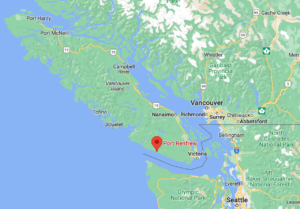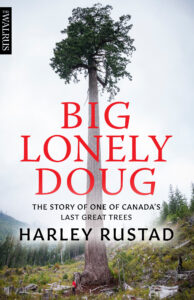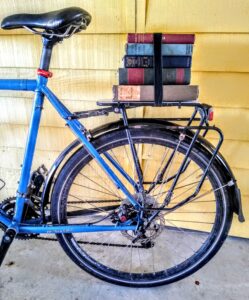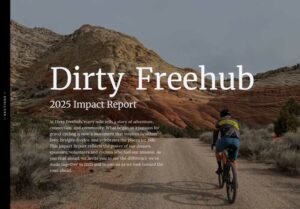
READ about the massive old-growth trees on Vancouver Island.
Then RIDE the gravel roads to bring the pages to life.
It’s one thing to see massive trees in an old-growth forest as you cycle along beautiful gravel roads.
It’s another thing to understand the significance, history, and impact of the trees.
READ to learn about the old-growth trees on southwest Vancouver Island.
Then RIDE to meet the trees in-person.
But don’t just whiz by.
Stop and stand beneath the trees’ towering limbs.
Feel their awe and wonder.
Feel a connection to the trees. Perhaps even feel inspired to help save them.
After all, the first step in conserving something is knowing it; the second step is loving it.
Introduction
 It’s the winter of 2011. Dennis Cronin has just stepped foot onto cutblock number 7190, located near Port Renfrew in the southwest corner of British Columbia’s Vancouver Island. As a forest engineer, Cronin’s responsibility is to survey an area the size of twelve football fields and create cutting maps for his company’s loggers. He uses pink ribbons to demarcate the location of logging roads. He uses orange ribbons to tag trees that should remain standing to buffer riparian zones for spawning salmons and save wildlife habitats.
It’s the winter of 2011. Dennis Cronin has just stepped foot onto cutblock number 7190, located near Port Renfrew in the southwest corner of British Columbia’s Vancouver Island. As a forest engineer, Cronin’s responsibility is to survey an area the size of twelve football fields and create cutting maps for his company’s loggers. He uses pink ribbons to demarcate the location of logging roads. He uses orange ribbons to tag trees that should remain standing to buffer riparian zones for spawning salmons and save wildlife habitats.
As Cronin walks through the cutblock, he comes across a tree that gives him pause. The tree is so large he could easily hide his truck behind its trunk.
“Encased within the deeply crevassed bark of this Douglas fir lay enough wood to fill four logging trucks to capacity, with some to spare. If milled into dimensional lumber — two-by-fours, two-by-sixes, and the like — it could be used to frame five 2,000-square-foot houses. At first glance, [Dennis Cronin] assessed the single tree and unprocessed log value at around $20,000. But since it was a Douglas fir, with its coveted warm colour and pronounced grain, the tree could be turned into higher-priced beams and posts for houses in Victoria and Vancouver. The single tree could fetch more than $50,000.”
Something tells Cronin to save this tree. Around the massive trunk, he ties a green ribbon indicating “Leave Tree.” The tree is surrounded by a stately group of brother and sister old-growth firs. But after cutblock number 7190 is felled, the tree will stand alone. At 230 ft tall, the tree happens to be the second largest fir in all of Canada, but Cronin doesn’t know that yet. Cronin also doesn’t know that the tree he is tagging, soon to be known as “Big Lonely Doug,” will become a symbol for conservation in Canada and abroad.
The READ

Author Harley Rustad captures the story of Vancouver Island’s magnificent forests in the book Big Lonely Doug: The Story of One of Canada’s Last Great Trees. The book tells not only about Big Lonely Doug, but of other magnificent old-growth trees – many 15 feet wide and 1000 years old – that reside near Port Renfrew in the lush Gordon River Valley. The story also tells about the loggers, treehuggers, Indigenous people, and communities, all which have a stake in the trees.
“Both activists and loggers are hunting for the same thing: the island’s lush valley bottoms, where trees of the Pacific temperate rainforest not only grow well, they grow big. There stood great value for both parties. To the loggers, each great tree, if felled, represented tens of thousands of dollars in prized timber. And to the environmental activist, the groves, if left standing, could be turned into a park or recreation zone for tourists and hikers.”
Goodreads describes the book as follows: “Originally featured as a long-form article in The Walrus that garnered a National Magazine Award (Silver), Big Lonely Doug weaves the ecology of old-growth forests, the legend of the West Coast’s big trees, the turbulence of the logging industry, the fight for preservation, the contention surrounding ecotourism, First Nations land and resource rights, and the fraught future of these ancient forests around the story of a logger who saved one of Canada’s last great trees.”
The RIDES

While the remote and rugged logging roads of southwest Vancouver Island are a deterrent for many visitors, for gravel cyclists, these roads make our hearts sing. Dirty Freehub has created a handful of 5-star gravel routes, varying in length from 12 to 80 miles (20 to 125 km), that you can pedal to bring Big Lonely Doug to life. These routes will take you to see various well-known trees in southwest Vancouver Island. Depending on the route, you can meet the Big Lonely Doug, the Red Creek Fir, the San Juan Spruce, the Harris Creek Spruce, the Eden and Avatar Groves, and even the tiniest well-known tree on Fairy Lake. You’ll visit the communities where loggers, activists, and the Pacheedahts reside. All of the routes will begin and end in Port Renfrew, Tall Tree Capital of Canada.
Video Launch — Interview with Harley Rustad & Overview of Routes
A Launch Party was held on July 12, 2023 at Crow’s Feet in Bend, OR. For those who were unable to attend, we have curated the best of the evening into three videos.
Part 1: Interview with Harley Rustad, author of Big Lonely Doug
Part 2: Salty Beard Bikepacking’s Adventure to Big Lonely Doug
Salty Beard Bikepacking’s video, which highlights a similar ride to the ones featured here, shows the scenery and terrain you’ll see on the READ & RIDE routes.
Part 3: Overview of Bike Routes
Podcasts
Other Ways to Learn About Big Lonely Doug
Here are other resources to learn about Big Lonely Doug and the old-growth forests in Southwest Vancouver Island.
Articles
- Big Lonely Doug: This magazine article, written by Harley Rustad and published in The Walrus, sparked the writing of Big Lonely Doug.
Documentaries
- Climbing Big Lonely Doug (3 minutes): This video uses drone footage to shows what it’s like to climb Big Lonely Doug.
- Giant Tree Hunters (19 minutes): This documentary follows TJ Watt and two big tree climbers as they hunt for the biggest trees in southern Vancouver Island.
Photographs
- TJ Watt – Big Tree Photographer: Check out TJ’s incredible photography of big trees. His Before & After series, which he talks about in his podcast above, is particularly touching.
Maps
- Avatar Grove & Port Renfrew Big Trees Map: This map shows the big trees in the Port Renfrew vicinity.
Ways You Can Help Save the Old-Growth Forests in Canada
- Send a pre-populated message to the British Columbia government via the Ancient Forest Alliance
- Send a message to the British Columbia government via the Endangered Ecosystems Alliance
- Make a tax-deductible contribution to the Nature-Based Solutions Foundation
About The Author
 Harley Rustad is the author of Big Lonely Doug: The Story of One of Canada’s Last Great Trees, about the second-largest Douglas-fir in Canada that was saved by a logger and turned into an environmental icon. It was named a best book of 2018 by the Globe and Mail and a best Canadian non-fiction book of the year by the CBC, and was nominated for the Shaughnessy Cohen Prize for Political Writing.
Harley Rustad is the author of Big Lonely Doug: The Story of One of Canada’s Last Great Trees, about the second-largest Douglas-fir in Canada that was saved by a logger and turned into an environmental icon. It was named a best book of 2018 by the Globe and Mail and a best Canadian non-fiction book of the year by the CBC, and was nominated for the Shaughnessy Cohen Prize for Political Writing.
His second book is Lost in the Valley of Death: A Story of Obsession and Danger in the Himalayas, the true story of the mysterious disappearance in 2016 of Justin Alexander Shetler in the Parvati Valley, India. It was named a best Canadian non-fiction book of the year by the CBC and featured on the cover of the the New York Times Book Review.
His writing has appeared in Outside magazine, The Walrus, the Globe and Mail, Geographical, the Guardian, CNN, and elsewhere. He is a senior editor at The Walrus magazine, a faculty editor at the Banff Centre’s mountain and wilderness writing residency, and the founder of the Port Renfrew Writers’ Retreat. A fellow of the Royal Geographical Society, Harley is originally from Salt Spring Island, British Columbia, Canada.
(From www.HarleyRustad.com)

 Join the Dirty Freehub co-founders this Thursday for an in-depth look at the
Join the Dirty Freehub co-founders this Thursday for an in-depth look at the